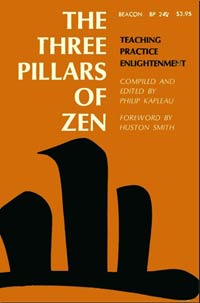The history of the Rochester Zen Center begins overseas with the Nuremberg and Tokyo War Crimes Trials at the close of World War II. Trying to come to grips with the appalling testimony he heard as a court reporter, 33-year-old Philip Kapleau began a spiritual search that would lead him to a Japanese Zen Buddhist monastery in 1953. 
One of the earliest readers of the book was a Batavia resident named Ralph Chapin, who saw the galley proofs while visiting Japan and, intrigued, asked that 10 copies be sent him when the book was published. When they arrived, he passed one on to his Rochester friends Chester Carlson (the inventor of xerography) and his wife Dorris. In March of 1966, Mrs. Carlson invited Philip Kapleau to come to Rochester and work with her meditation group, and in June the Zen Meditation Center came into being with a membership of 22. The Center’s first sesshin took place in October, and the first issue of its newsletter, Zen Bow, appeared in 1967.